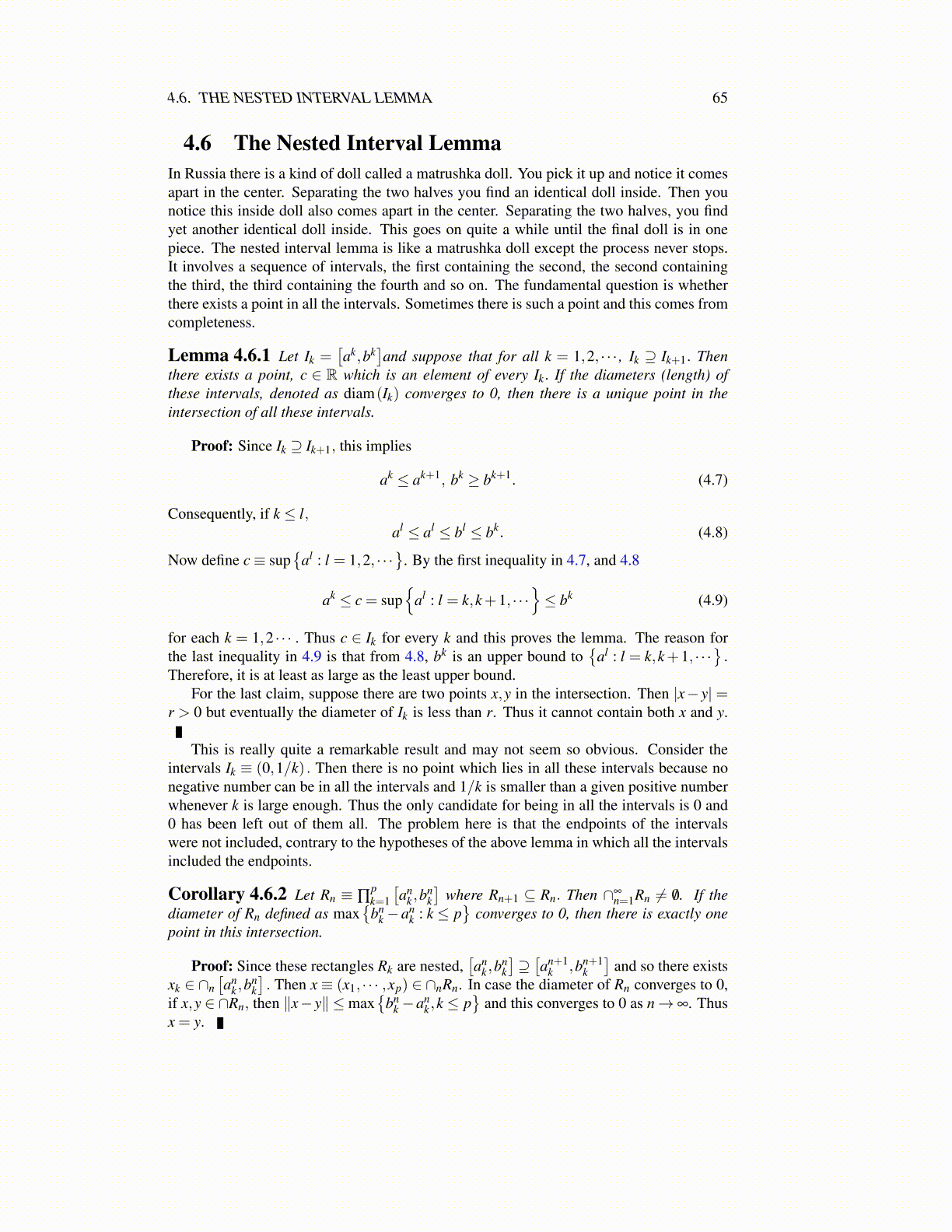
4.8. COMPACTNESS 65
15. Let An = ∑nk=2
1k(k−1) for n ≥ 2. Show limn→∞ An exists and find the limit. Hint:
Show there exists an upper bound to the An as follows.
n
∑k=2
1k (k−1)
=n
∑k=2
(1
k−1− 1
k
)= 1− 1
n≤ 1.
16. Let Hn = ∑nk=1
1k2 for n ≥ 2. Show limn→∞ Hn exists. Hint: Use the above problem
to obtain the existence of an upper bound.
17. Let In = (−1/n,1/n) and let Jn = (0,2/n) . The intervals, In and Jn are open in-tervals of length 2/n. Find ∩∞
n=1In and ∩∞n=1Jn. Repeat the same problem for In =
(−1/n,1/n] and Jn = [0,2/n).
18. Show the set of real numbers [0,1] is not countable. That is, show that there can beno mapping fromN onto [0,1]. Hint: Show that every sequence, the terms consistingonly of 0 or 1 determines a unique point of [0,1] . Call this map γ. Show it is onto.Also show that there is a map from [0,1] onto S , the set of sequences of zeros andones. This will involve the nested interval lemma. Thus there is a one to one andonto map α from S to [0,1] by Corollary 3.2.5. Next show that there is a one toone and onto map from this set of sequences and P (N). Consider θ ({an}∞
n=1) ={n : an = 1} . Now suppose that f : N→ [0,1] is onto. Then θ ◦α−1 ◦ f is ontoP (N). Recall that there is no map from a set to its power set. Review why this is.
19. Show that if I and J are any two closed intervals, then there is a one to one and ontomap from I to J. Thus from the above problem, no closed interval, however shortcan be countable.
4.8 Compactness4.8.1 Sequential CompactnessFirst I will discuss the very important concept of sequential compactness. This is a propertythat some sets have. A set of numbers is sequentially compact if every sequence containedin the set has a subsequence which converges to a point in the set. It is unbelievably usefulwhenever you try to understand existence theorems.
Definition 4.8.1 A set, K ⊆ Fp is sequentially compact if whenever {an} ⊆ K isa sequence, there exists a subsequence,
{ank
}such that this subsequence converges to a
point of K.
The following theorem is part of the Heine Borel theorem.
Theorem 4.8.2 Every closed interval [a,b] is sequentially compact.
Proof: Let {xn} ⊆ [a,b] ≡ I0. Consider the two intervals[a, a+b
2
]and
[ a+b2 ,b
]each
of which has length (b−a)/2. At least one of these intervals contains xn for infinitelymany values of n. Call this interval I1. Now do for I1 what was done for I0. Split it in halfand let I2 be the interval which contains xn for infinitely many values of n. Continue thisway obtaining a sequence of nested intervals I0 ⊇ I1 ⊇ I2 ⊇ I3 · · · where the length of In is(b−a)/2n. Now pick n1 such that xn1 ∈ I1, n2 such that n2 > n1 and xn2 ∈ I2,n3 such that